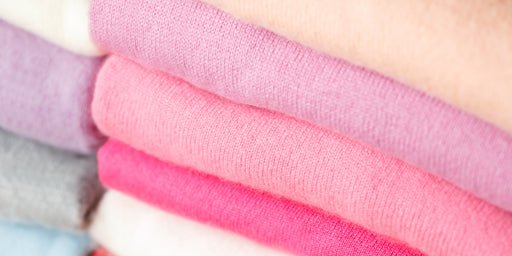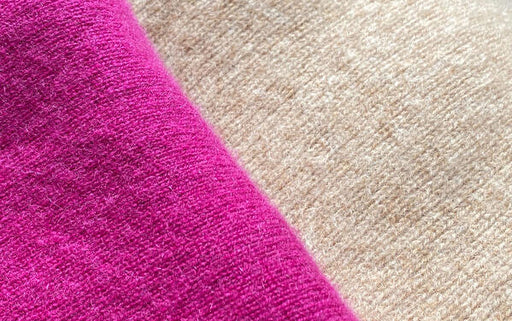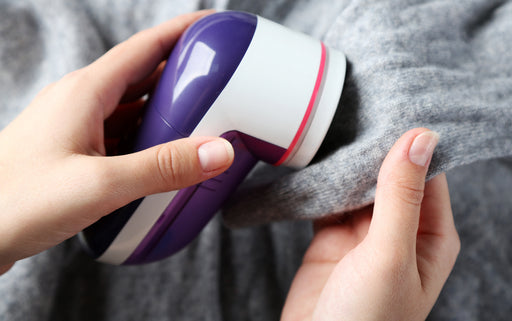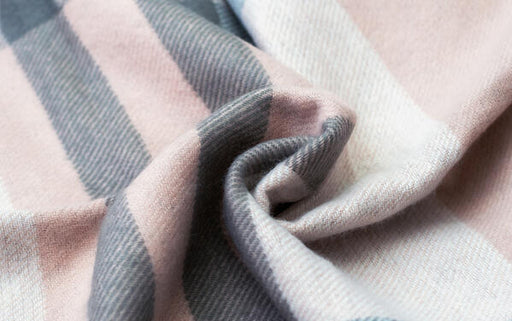How To Deal With Cashmere Pilling

You’ve done everything right. You hand-wash your cashmere with a mild detergent, you make sure it dries flat, you fold it rather than hang it for storage — but you’re still plagued by pilling! Those annoying little tufts of fabric make even the most luxurious cashmere look like a dollar store rag.
Pilling may be unavoidable for certain types of cashmere garments, but you can minimize pilling or remove existing pilling easily. With this guide, we’ll help you keep your favourite pieces in shape and looking good for a long time to come.
What Causes Pilling on Cashmere Garments?
Cashmere is not the only textile prone to pilling, but given its expense relative to the cost of other natural fibres, it’s especially frustrating that it does. Three basic factors come into play: the fibre quality of your cashmere piece, your wearing habits and where you wear it.
Quality
Judging the overall quality of a cashmere garment depends on several variables, but raw cashmere wool falls into one of three graded categories:
Grade A: Long, fine fibres that can measure as low as 14 microns in width (1 micron = 0.001 mm) and 34 millimetres in length.
Grade B: Although thicker and longer on average compared to Grade A, Grade B fibres still make high-quality cashmere.
Grade C: Low quality cashmere can still make expensive products, but these textiles have a shorter lifespan and do not feel as soft as those made from higher quality grades.
Does good quality cashmere pill?
Sadly, yes. All cashmere will pill no matter what you do — but low-quality cashmere may pill immediately if you rub a layer of it between your fingers.
This happens due to the grade’s shorter, thicker fibres. When spun together, natural fibres interlock, which is how we get yarn. Long, thin fibres form a stronger bond than short, thick ones do, so even a little friction will pull apart a low-grade garment more easily than a higher quality piece.
You can still make inexpensive cashmere work for you, so don’t give your bargain buys the side-eye just yet. Check out our notes below on what to watch out for when it comes to wearing your cashmere and protecting it from exposure to the elements.

Wear
When it comes to solving the riddle of the pilled sweater, analysing how one wears a cashmere garment provides most of the clues we need. Even the most expensive, highest quality cashmere is going to pill all over if you’re wearing it roughly.
Roughly, that is, by cashmere’s standards. Layering clothing is a popular way to stay cool enough while indoors and warm enough once it’s time to go out — but if your cashmere winds up as a middle layer, you’re increasing the chance it will pill.
Pilling itself may seem only a cosmetic concern, but consider this — it’s a bobble of knotted fabric still stuck to an otherwise intact strand. Should it catch on a button or a ring and snag, you could be dealing with actual damage instead of just a slight case of shedding.
Even with careful wear, you’re still likely to find pilling takes place around the neckline, hems and any cuffs of your cashmere garment. Anywhere the fabric creases while worn, like beneath the arms, is also prone to pilling rapidly.
Environment
You’re not likely to pack your best cashmere sweater for a mountain climbing expedition, but the warmth and softness of cashmere makes it a popular choice for winter wear. This may mean some form of precipitation — rain or snow or a spilled holiday party cider — makes it onto the surface of your favourite cardigan.
A quick wash may take care of any discoloration or stain, but any of those previously damp splotches poses a risk while it’s still being worn. Cashmere is at its most vulnerable when wet. Natural fibres like wool lose their shape and stretch once they’ve become saturated, which causes breakage — and breakage leads to pilling.
However, environmental concerns aren’t just about what happens outside the home. What’s happening inside your home can also impact how frequently you’re waging war on those persistent little fuzzballs. Your storage practices play a big part in how well your cashmere keeps and for how long you get to keep it.
What actually causes pilling is simple: friction between fibres. While the integrity of those fibres and the natural strain of wear are obvious ways these fibres rub against one another, cashmere garments aren’t immune to friction while in storage.
In our guides for how to take care of and store cashmere properly, we highlight the importance of protecting each layer of cashmere from touching the next. That’s why acid-free tissue paper is one of our favourite solutions to this problem.
A layer of tissue paper between the folds of a natural-fibre garment keeps the thin wisps of wool that makes cashmere so luscious to the touch from tangling together while hibernating. It can also prevent any remnants of body oils or perspiration from transferring to another piece of the garment, causing further damage and risk of pill balls.
Be sure not to stack cashmere garments too tightly on top of one another, too. The compression this causes risks further shredding the bond between those natural fibres, which may not mean you see any pilling when you pull the garments out again… but it will surely show up soon after wearing it.
Tools & Tips for Removing Cashmere Pilling
Now that you know how to watch out for the causes of pilling, it’s time to learn what to do with those clumps of broken fibres when they pop up.

Common tools used for depilling cashmere
- Cashmere or sweater comb. Arguably one of the more traditional and perhaps safer methods of pill removal, a fine-toothed comb is a popular and inexpensive choice. The trick is to start with a clean, dry garment laid flat, then comb downward to gently detangle fuzzballs.
- Fabric shaver. You may have seen some lifehackers insist that a simple, single-blade razor that you’d use in the shower can depill your favourite sweater. While the fabric shaver proves this concept true, you’re much better off using one designed to work with cashmere than you are the shaver from the shower. Garment shavers work by electronically shearing off the little knobs of fabric from the surface of the fabric.
- Lint roller. These may be made with sticky, disposable adhesive patches or with a felted fabric that catches stray bits from the surface of a garment and clings to it until cleaned off.
- Lint stone. A natural pumice stone used much like a comb, with the effects of a shaver. The garment is laid out dry and flat before you glide the pumice stone down the garment’s surface. The pock-marked surface of the pumice catches each little fuzzball and gently tugs it free from its tangle.
- Scissors. Obviously, snipping each pill one by one would be a huge chore if you have a lot of them to clear off. But, if you just have a few errant knots gathering, you can gently clip it off. The finer the point and the sharper the scissors are, the better off you’ll be.


If you’re trying to choose the option that will help you preserve your garments the longest, try to use tools that do not cause unnecessary stress to the fabric itself. You can avoid tugging with a comb or stone by using a light, gentle touch — but if your shaver is dull or your lint roller’s adhesive extra sticky, they could wind up snagging a pill instead of removing it.
Are you ready for some insider tips that will help you keep your cashmere in perfect condition?
Tip #1: Don’t wash cashmere after every wear.
Now, before you think this runs contrary to how important it is to wash your cashmere before you store it, let’s clarify. If it’s the season for wearing your favourite cashmere pieces and you intend to use them more than once in the same month, you’re most likely in the clear when it comes to waiting on that post-wear wash.
Even a gentle wash will cause the natural fibres of your cashmere piece to push and rub together, and we know that kind of friction is exactly what causes pilling to happen in the first place. If you can manage to wait a wear or two between washes, you can prevent excessive pilling from developing.
Naturally, if you think any of your natural body oils or perspiration may build up too quickly, washing it after every wear is a must. Plus, be sure to treat any stains immediately (and you know we can help you solve that problem, too).
Tip #2: Never scrub or twist the cashmere garment.
When you see a speck, spot or stain, your first instinct is to whip out a washcloth and get to scrubbing. With cashmere, this is the last thing you should do. All that pressure stretches the wet strands of wool and can cause them to break.
Even a little breakage that might not be seen to the naked eye can quickly develop into a stubborn knot that winds itself to the surface of the garment. If you’re spot-treating or just washing by hand as part of your regular cleaning schedule, be sure to dab and squeeze gently instead of scrubbing and twisting.
For more on removing stains on cashmere, check out our blog.
Tip #3: Wash cashmere clothes and dry inside-out.
If you’re hand-washing or machine-washing your cashmere garments at home, make sure to flip them inside-out beforehand. This may not seem like it matters much if you’re washing each item on its own by hand, but even then it can reduce the amount of friction the outer surface of the garment experiences.
It makes even more sense if you’re washing similar items together. Fundamentally, there’s nothing different between the outside or the inside of a garment, but each pill that develops is essentially thinning the surrounding strands of yarn its fibres come from. The thinking behind this step, then, is that this should occur from the inside rather than out.
Read more about washing tips for cashmere.
Tip #4: Give your cashmere garments breathing room in the closet.
Cashmere clothing doesn’t need to sit one item to a shelf in the closet, but you do need to avoid stacking them one on top of the other until they’re stuffed and flattened. As we mentioned earlier, that kind of pressure strains the bonds between natural fibres, stretching them out of shape and making them more likely to bunch up into tiny knots.
Remember our tip about folding acid-free tissue paper between the layers? Don’t skip it in between long-term storage seasons. Use the paper between those folds even when your cashmere items are in a regular-wear cycle. You don’t have to change them out for fresh paper every time until you’re ready to prep your closet for that long-term stretch.
Check out more tips on wardrobe organisation on our blog!
Tip#5: When in doubt, ask for a professional’s help.
Most of these tools and tricks work just fine for the average person with modern-day cashmere garments. If you’re the proud owner of an heirloom piece or a high-end, haute couture garment, then you may need the help of a specialist if you need to remove pills.
The process is much the same, but a garment specialist — which could be your local dry cleaner or a skilled costumer — will know just how much stress your precious piece can take. They may be able to teach you how to maintain it in between visits, as well, if you’re comfortable learning. In special cases such as these, however, your best practice is early intervention and careful wear.

Don't forget to protect your cashmere from clothes moths! Check out our range of clothes moth traps to protect your clothes.
No matter which tool, tip or technique you try for yourself, start slow, use a gentle touch and never attempt to depill a wet or dirty garment. Simple steps like these are all it takes to maintain the value and extend the life of your favourite cashmere pieces.
You can check out more cashmere care tips on our blog!
About MothPrevention
MothPrevention® speak to customers every day about their clothes moth issues - clothes moths are a species that are ever increasing and that can cause significant damage to clothes, carpets and other home textiles.
To date, we’ve helped over 250,000 customers deal with their moth problems. We have developed professional grade solutions including proprietary pheromones and trap design engineered to the highest production standards.





